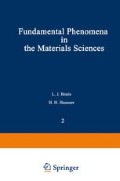Abstract
The surface of a material—solid or liquid—is “clean,” if there are no adsorbed foreign atoms or molecules on the surface and no chemisorbed or absorbed foreign atoms or molecules in the surface layers. The simplest way to visualize such a clean surface is to break a piece of solid pure metal.
Access this chapter
Tax calculation will be finalised at checkout
Purchases are for personal use only
Preview
Unable to display preview. Download preview PDF.
References
B. B. Dayton. “Relations Between Size of Vacuum Chamber, Outgassing Rate, and Required Pumping Speed,” Trans. Vacuum Symp. Am. Vacuum Soc. 101–119, 1959.
B. B. Dayton, ‘Outgassing Rate of Contaminated Metal Surfaces,“ Trans. Vacuum Symp. Am. Vacuum Soc. 42–57, 1961.
Imre Farkass and E. J. Barry, °Improved Elastomer Seal Designs for Large Metal Ultrahigh Vacuum Systems Permitting Ultimate Pressures in the Low 10–10 mm Hg Range,’ Trans. Vacuum Symp. Am. Vacuum Soc. 35–38,. 1960.
Imre Farkass and E. J. Barry, “Study of Sealants for Space Environment,” Summary Report to the Army Ballistic Missile Agency, U.S. Army Ordnance Missile Command, Contract DA–19–020–506–ORD–5097, January 1961.
L. J. Bonis and G. S. Ansell, “Materials Selection and Development for Application in Inter-Planetary Vehicles,” Trans. Vacuum Symp. Am. Vacuum Soc. 286–292, 1962.
L. J. Bonis and Imre Farkas s, “Ultrahigh Vacuum Environmental Testing and Materials Development for the Apollo Guidance System,” Final Report to Massachusetts Institute of Technology Instrumentation Laboratory, Subcontract No. 208 (NASA Contract NAS9–153), March 1963.
J. A. Becker. “Adsorption on Metal Surfaces and its Bearing on Catalysis,’ Advances in Catalysis, Vol. 7, 1955.
Imre Farkass, “Ultrahigh Vacuum Design for Large Space Simulation Systems,” Proc. Inst. Environ. Sci. 95 and 137–146, 1962.
Imre Farkass, ‘Metal Ultrahigh Vacuum Systems,“ Report on the Twenty-Second Ann. Conf. Phys. Electronics, Massachusetts Institute of Technology, pp. 315–324, 1962.
hure Farkass, P. R. Gould, and G. W. Horn, “1 • 10 11Torr in Large Metal Chambers, Its Attainment and Application Results,” Trans. Vacuum Symp. Am. Vacuum Soc. 273–277, 1962.
Imre Farkass and E. J. Barry, “ The Origins and Composition of the Limiting Gas Load in Ultrahigh Vacuum Systems,” Trans. Vacuum Symp. Am. Vacuum Soc. 66–72, 1961.
John C. L. Shabeck, Jr., “Operation of a 20 Cubic Foot Chamber in the 10–11 Torr Range,” Trans. Vacuum Symp. Am. Vacuum Soc. 278–281, 1962.
Imre Farkass and G. W. Horn, “Cryogenic Pumping in Space Simulators,” 56th Ann. Meeting Am. Inst. Chem. Engrs., Paper No. 45-b, 1963.
Author information
Authors and Affiliations
Editor information
Editors and Affiliations
Rights and permissions
Copyright information
© 1966 Plenum Press
About this chapter
Cite this chapter
Farkass, I. (1966). Problems of Producing a Clean Surface by Outgassing in Ultrahigh Vacuum. In: Bonis, L.J., Hausner, H.H. (eds) Fundamental Phenomena in the Materials Sciences. Springer, Boston, MA. https://doi.org/10.1007/978-1-4684-8703-9_6
Download citation
DOI: https://doi.org/10.1007/978-1-4684-8703-9_6
Publisher Name: Springer, Boston, MA
Print ISBN: 978-1-4684-8705-3
Online ISBN: 978-1-4684-8703-9
eBook Packages: Springer Book Archive

